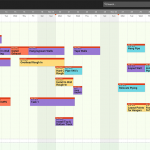Lean is the means to save your company money. Lots of money. When starting the basic research into Lean, this fact gets lost in between the explanations of capturing value, pull planning and the Toyota Way. At its core, Lean is the means to save money through a reduction of waste and an increase of efficiency. It is the strategy by which we avoid making tradeoffs in time, cost, and quality.
How does Lean accomplish these incredible things? Lean works by focusing on the process used to create your project as much as you focus on the end product itself. By evaluating the means through which we achieve the ends we can eliminate much of the time- and money-sucking inefficiencies that currently exist. To accomplish this, the Lean process starts at the end and moves backwards to plan out the work.
Doing things backwards allows you to identify only the work that is needed to achieve your milestones or conditions of satisfaction. Completing work only when it is required and not out of sequence reduces damaged product that would require rework or replacement. Lean also makes sure that you are not spending money on resources until they are immediately necessary for the task at hand.
This system wide approach is far more effective at lowering your cost, because it eliminates waste along the entire production stream as opposed to at individual points or problem areas. The language used to describe the “Lean Process” can make it seem overwhelming when getting starting, but at its core Lean is simply the best way to maximize value to your customers and minimize your waste.
Doing this will save you money. Lots of money. If you would like to dig deeper into the guiding principles of Lean, we have a page for that too.










